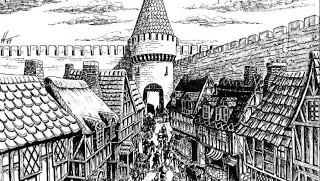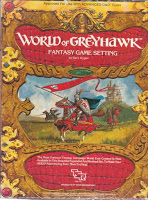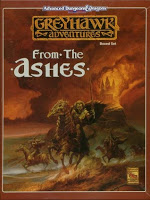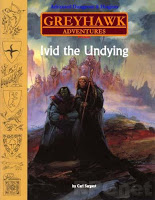I’ve been working on a top-secret project lately (in and around all my not-so-secret projects), and have been doing some research on the various cities of the Flanaess in the World of Greyhawk. Some of it was fairly straightforward, but I noticed something extraordinary as I got into the data.
In CY 576 (the era described by both the original folio and “gold box” set), the wonderful Darlene map indicated which of the settlements were capitals, cities, and towns (distinguishing between walled towns and those which were unwalled). These map symbols tell us where the cities are. The text tells us the definition of a “city” in this context; cities have 10,000 or more inhabitants (usually humans; demi-humans and humanoids are usually not counted in the straight population totals, but are broken out separately).
When applied to the original map, we get a fairly small number of cities overall, especially when combined with the text in the Guide book, which informs us that not all national capitals have 10,000 people, and thus not all qualify as cities. By my count I make it 62 true cities. If that sounds like a lot, there are several times that many other settlements marked on the map!
There is a slight qualifier here; some of the symbols as originally printed in that 1980 map are exceedingly difficult to tell apart. Cities have two concentric and very fine circles with the space between the lines marked off in an alternating pattern. Towns don’t have the markings between the rings. Sometimes you need a magnifying glass to tell them apart.
Now along comes the From the Ashes boxed set (CY 585). It had a map that was mostly the same as the original, but the settlement markers were both larger and more homogenized. No longer was a distinction made on the map between a walled town, an unwalled town, and a city. If the population (or presence of walls) wasn’t in the text, you were on your own.
Given the upheavals in the setting between 576 and 585, one would expect to see some population fluctuations among the cities, and indeed we do. Rauxes sheds nearly 19,000 people, Greyhawk and most of the other free cities gain, and two settlements are wiped from the rolls of cities altogether and reduced to the status of towns; Admundfort and Lo Relatarma. All perfectly consistent within the confines of the setting.
The big issue comes in after the publication of FtA. The unpublished manuscript of Ivid the Undying, which was later released as a free pdf by both TSR and WotC, engages in an incredible amount of “city bloat”. Almost a dozen settlements that were clearly towns in the original Darlene map are given populations appropriate to cities. Was this sloppy editing? The result of not realizing towns and cities were distinguished on the original maps? Whatever the cause, suddenly the population centers of the “ravaged lands” of Aerdy were booming to many times their original size.
I have only done a spot-check of other, similar products from the era such as The Marklands and Iuz the Evil, and see a similar trend. Many places that were clearly towns before are now listed as having city-sized populations.
This trend was continued and exacerbated in the Living Greyhawk Gazetteer, which took the setting to CY 591. To take but one example, Nyrond, which in 576 was listed as having but two actual cities, is now said to be home to ten places with ten thousand or more souls. (And it’s not because the borders shifted!)
I have to wonder whether this was a deliberate design choice on the part of folks like Carl Sargent, Gary Holian, Sean Reynolds, Roger Moore, and Erik Mona. I can’t imagine it was ignorance or slipshod work on their part. Are smaller settlements just not considered game-worthy? Was it an attempt to try to justify the large populations for the lands as a whole? I don’t have a definitive reason, but would love to hear if anyone has one (or some other theories).













Almost a dozen settlements that were clearly towns in the original Darlene map are given populations appropriate to cities.
Refugees hiding from the chaos of the surrounding lands behind those nice thick city wall would seem the most obvious rationale for the various jumps in urban population.
That, and a correction over time of the relative (howling) emptiness of the Darlene map.
Historically speaking, packing those sorts of numbers of people into towns (we're talking about increasing populations by factors of 3, 4, or more) would only work for a very short period of time before the infrastructure and supplies of the place were exhausted. Afterwards they would either be expelled or start dying from various diseases and starvation.
I would also point out that many of the places that experienced such growth don't have walls to begin with. 😉
As for your last point, I refer you to a post I made on that subject a year and a half ago, Chris.
My memories of the decision-making process behind some of this stuff are getting weaker, but I am pretty sure that Gary Holian was the "population master" of the LGG, and that he provided all of the revised population numbers.
I THINK there was a general consensus among the regular Greytalk weekly chat group that the listed populations for the cities were out of whack with historical cities like Paris, so they revised the population numbers upward (though not into the heights of the Forgotten Realms, which routinely loaded hundreds of thousands or even millions of people into cities).
Another factor may have involved the 3.0 Dungeon Master's Guide, which pegged descriptive phrases ("small town," "metropolis," etc.) to actual demographic numbers. I suspect that may have been where Gary started, as WotC was insistent that our demographics match the DMG standards (this is why, for example, there are so many more demihumans in the population breakdowns of various places in the LGG).
Thank you for the insight into the design process there, Erik!
It does have interesting implications in terms of trying to do a version-neutral product, since it seems that the demographics varied from one edition to another, specifically because of edition-specific rules.
I would not worry too much about the growth of city populations and resources. Rather than look for reasons that they should not be possible, it is always more fruitful to come up with explanations for why they are. For instance, population growth will exhaust the resources available if the latter were limited to begin with. No reason any town with 5,000 people should not have the potential resources to feed 20,000.
Yeah, that was my recollection of the LGG work too – there was a lot of effort put into making the demographics more real-world realistic because a lot of basic assumptions don't really hold up unless there's a certain percentage of urbanization etc. "Fantasy and magic!" isn't really a good argument against it because that should tend to make people group up even more for mutual defense vs. ravening wandering monsters.